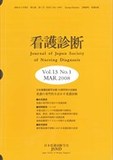Japanese
English
- 有料閲覧
- Abstract 文献概要
- 参考文献 Reference
本研究は,クリティカルケア看護領域における心理社会的看護診断ラベル,診断指標,関連/危険因子の使用頻度を調べ,状況的危機との関係を明らかにすること,その診断プロセスの特徴について探索・記述し,今後の課題を検討することを目的とした.2施設の入院看護記録4,549例を対象に,各項目を抽出し,Aguileraの危機モデルを参考に状況的危機について分析した.その結果,15ラベル,96件の心理社会的看護診断が使用されており,【不安】,【予期悲嘆】,【非効果的コーピング】の頻度が高く,上位3項目を占めていた.診断指標は1例あたり平均1.7項目未満で,関連/危険因子に関しては,曖昧な選択がされていた.これらの心理社会的看護診断において,状況的危機と判定できるものは該当なしであり,また,心理社会的看護診断は使用されていなかったが,状況的危機と判定できるものは16例であった.したがって,クリティカルケア看護領域において,状況的危機と判断したうえでの具体的な心理社会的看護診断は認められず,診断プロセスの特徴として明らかな結果は得られなかった.
The purpose of this study was to clarify the actual psychosocial nursing diagnoses labels, defining characteristics and related/risk factors for the situational crises, and the characteristics of diagnosis process, in the critical care nursing. Data were collected by a researcher from nursing records of 4,549 patients in two hospitals, and we analyzed based on Aguilera's crisis model. As a result, for example,“Anxiety”, “Anticipatory Grieving”, or“Ineffective Coping”, 15 labels, 96 nursing diagnoses were used in the critical care nursing. The defining characteristics were used with under an average of 1.7 items, and related/risk factors were vague. In 96 diagnoses, there were not the things which we could judge to be the situational crisis, and we could judge 16 situational crises in other than these. Therefore, in the critical care nursing, the psychosocial nursing diagnosis for the situational crises and the characteristic of the diagnosis process was not to clarify.
Copyright © 2008, Japan Society of Nursing Diagnosis. All rights reserved.


